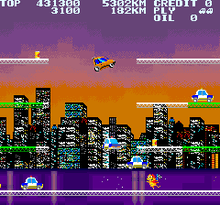City Connection
| City Connection | |
|---|---|
 Title screen of the original arcade version | |
| Developer(s) | Axes Art Amuse |
| Publisher(s) | Jaleco, Kitcorp |
| Platform(s) | Arcade NES MSX Virtual Console |
| Release date(s) | 1985 |
| Genre(s) | Platform Racing |
| Mode(s) | Two players alternating turns |
| Cabinet | Upright, Cocktail |
| CPU | M6809 (@ 2.048 MHz) |
| Sound | Sound CPU: M6809 (@ 640 kHz). Sound Chips: AY8910 (@ 1.25 MHz), YM2203 (@ 1.25 MHz) |
| Display | Raster, 240 x 224 pixels (Horizontal), 1664 colors |
City Connection (シティコネクション Shiti Konekushon) is a video game developed and published in 1985 by Jaleco for the arcade in Japan and published by Kitcorp as Cruisin' outside of Japan.
The game supports up to two players (playing alternatively). It's a platform game in which the player controls a car that can never be stopped. The car normally moves at the same speed, although the player can push in the direction the car is moving to make it drive slightly faster. It can only 180° handbrake turn or jump (normal jump or high jump). The object of the game is to drive through a series of cities and paint every part of the roads in each city as proof of the player's visit to that city. City Connection was remarkable for its time in that each location had its own background and music which was a variation on the main theme of the game. There are twelve locations: Manhattan, the Grand Canyon, Easter Island, Paris, Neuschwanstein Castle, London, Sydney, Egyptian temples, and cities in India, Holland, China and Japan.
Gameplay

The main character in the game is a female driver, Clarice, of a Honda City (the North American version features a male driver) on a tour of all the sights and roads across the world. To prove that she has visited a particular location, she must drive around the location painting every section of the road white. However, the police, who have no tolerance for vandalism, attempt to stop the driver from completing her goal. The player's car can jump and fire cans of oil.
To avoid forcing the player from retracing the same roads again, the roads change color when the car drives over them, indicating that that specific road has been painted. There are three main obstacles: police, cats, and spikes. The police chase after the car, and if a police car comes into contact with the main character's car, the car "explodes" by turning into a group of hearts, and the player loses a life. To combat this, the player can obtain cans of oil, which can be used to cause the police cars to spin out of control, allowing the player to bump them off the screen. Other enemies include a cat, which, when hit, causes the player to lose an extra life as the cat goes diagonally off the screen (but does not cause the car to "explode") with playing of a comical music, "Der Flohwalzer", known as "Neko Funjatta" (I Stepped on the Cat) in Japan. There is also spikes, which make the car "explode" on contact.
Occasionally, a balloon may float by during any given stage. If the car touches one of these balloons, it collects it, and collecting three such balloons will activate a warp that sends the car multiple stages ahead, and provides significant bonus points. Although the city you travel to will change, the difficulty pattern of the road will remain the same. As the number of cities you travel to loop endlessly, the game is not shortened by taking a warp.
One particular thing about this game is the "catchy" tune that plays in the background as you enter a new city. Although it uses "ethnic" variations according to the destination, it's an adaptation of a famous classic piece, "Allegro non troppo e molto maestoso", from Tchaikovsky's Piano Concerto No.1.
Ports and related releases

The arcade game was later ported to the MSX, ZX Spectrum and Nintendo Entertainment System.[1] The game has a sequel available on cellphones exclusively in Japan titled as City Connection Rocket (シティコネクション・ロケット).
At this game's 10th stage, players will be able to hear the opening theme of the 1960s Batman TV series, in a medley with the Tchaikovsky's music.
See also
References
- ↑ "Two WiiWare Games and Two Virtual Console Games Added to Wii Shop Channel". Nintendo of America. 2008-05-26. Retrieved 2008-05-27.
External links
- City Connection (Arcade) at GameFAQs
- City Connection (MSX) at GameFAQs
- City Connection (NES) at GameFAQs
- City Connection at MobyGames
- City Connection guide at StrategyWiki
- City Connection arcade screenshots
- City Connection Reloaded, remake of the game.